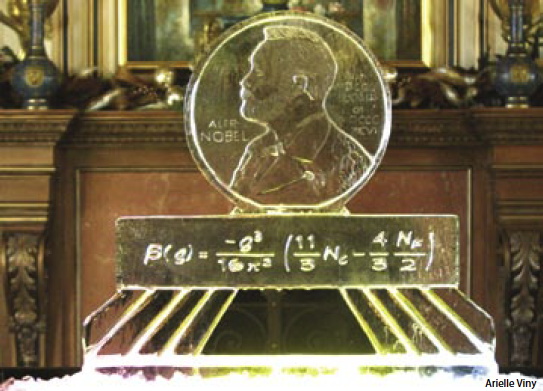 Frozen momentarily is the equation that garnered the Nobel Prize for David Gross. The ice sculpture was created for a Bon Voyage à Stockholm party in Gross’s honor, hosted by Fred and Linda Gluck at their Montecito home. Gluck endowed the chair in theoretical physics that Gross holds at UC Santa Barbara. Photo by Arielle Viny
Frozen momentarily is the equation that garnered the Nobel Prize for David Gross. The ice sculpture was created for a Bon Voyage à Stockholm party in Gross’s honor, hosted by Fred and Linda Gluck at their Montecito home. Gluck endowed the chair in theoretical physics that Gross holds at UC Santa Barbara. Photo by Arielle Viny
DAVID J. GROSS, director of the Kavli Institute for Theoretical Physics (KITP) and the first incumbent of the Frederick W. Gluck Chair in Theoretical Physics at the University of California, Santa Barbara, was awarded the 2004 Nobel Prize in Physics for solving in 1973 the last great remaining problem of what has since come to be called “the Standard Model” of the quantum mechanical picture of reality. He and his co-recipients discovered how the nucleus of atoms works.
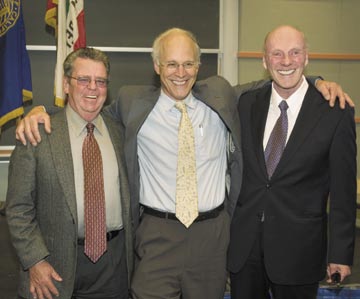 At the impromptu press conference held at KITP, laureate David Gross is flanked by the two “Freds” (Gluck [l] and Kavli), both generous Institute benefactors.
At the impromptu press conference held at KITP, laureate David Gross is flanked by the two “Freds” (Gluck [l] and Kavli), both generous Institute benefactors.
Photo by Tony Mastres.
Gross shares the prize with Frank Wilczek, who was Gross’s graduate student at Princeton University when the pair completed the calculation that resulted in the discovery for which they have received the Nobel Prize. Wilczek, now a physics professor at the Massachusetts Institute of Technology, was a permanent member of the then Institute for Theoretical Physics (ITP) at Santa Barbara from 1980 to 1988. The other recipient, H. David Politzer, a physics professor at the California Institute of Technology, was working independently on a similar calculation.
Gross was awoken shortly after 2:30 a.m. PST by a call from the Royal Swedish Academy of Sciences, and participated by phone in the press conference under way in Stockholm.
Gross said, “This Nobel Prize recognizes the efforts not only by us, but also the community of high energy physics. Scientific explorations into fundamental reality are no longer the province of the lone genius such as Galileo or Newton or Einstein, but a collaborative effort by a community of scientists. Hundreds of experimental physicists at the world’s accelerator laboratories have designed and run the experiments that gave us early hints about how the strong force operates and then, after we published our theory, proved it. The effort to explore the subtleties of the nuclear force continues today; we still have many implications of the theory to work out.”
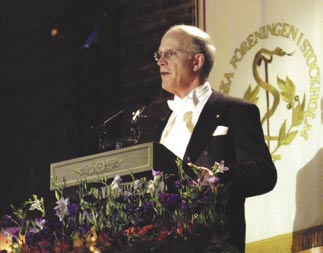 Gross gives the banquet address in Stockholm on behalf of the physics laureates. Photo courtesy Nobel Foundation.
Gross gives the banquet address in Stockholm on behalf of the physics laureates. Photo courtesy Nobel Foundation.
The Swedish Academy cited the winners “for the discovery of asymptotic freedom in the theory of the strong interaction.”
Gross and Wilczek, and independently, Politzer, made the key discovery of how the “strong” force works to bind the constituent elements, called "quarks," of protons and neutrons (the particles that make up the nucleus of atoms). The other three forces of nature — electromagnetism, the weak force (responsible for radioactive decay), and gravity all diminish in strength with distance. They discovered that the strong force grows weaker at short distances.
This discovery, called “asymptotic freedom,” means that quarks when observed at very high energies behave as essentially freely moving particles. This finding has had enormous implications for the design and conduct of experiments at the world’s large accelerator facilities because it has enabled physicists to calculate what the results of the experiments should be. Discrepancies from those calculated results in turn provide invaluable clues to new physics — i.e., physics beyond the Standard Model.
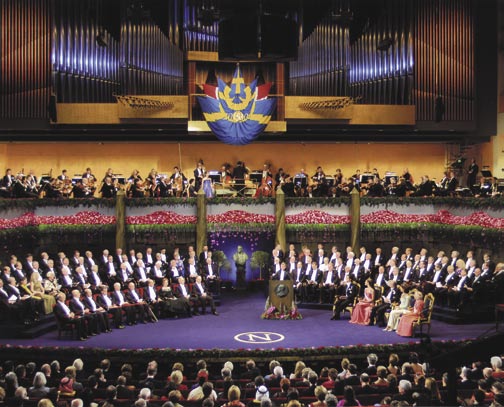 This is the stage setting for awarding of the 2004 Nobel Prizes. David Gross as the eldest physicist occupies first position (l) in the front row left of laureates; the Swedish Royals occupy front row right. Photo courtesy Nobel Foundation.
This is the stage setting for awarding of the 2004 Nobel Prizes. David Gross as the eldest physicist occupies first position (l) in the front row left of laureates; the Swedish Royals occupy front row right. Photo courtesy Nobel Foundation.
The flip side of “asymptotic freedom” has been described as “infra-red slavery.” Since the force that binds quarks inside protons and neutrons grows stronger with distance, protons and neutrons can’t be dismantled into constituent quarks. This part of the Gross-Wilczek discovery is called “confinement.”
The discovery of asymptotic freedom led Gross and Wilczek to propose a comprehensive theory of the strong or nuclear force called Quantum Chromodynamics (QCD), whose three color charges are analogous to the positive and negative charges in the theory of the electromagnetic force or Quantum Electrodynamics (QED). Because QCD bears remarkable mathematical similarity to QED, and also to the theory of the weak force, the key discovery of asymptotic freedom has brought “physics one step closer to fulfilling a grand dream, to formulate a unified theory comprising gravity as well — a theory of everything,” according to the announcement by the Swedish Academy.
After obtaining his PhD from UC Berkeley in 1966, Gross was invited to join the select group of junior fellows at Harvard. Having accepted an appointment as assistant professor at Princeton in 1969, he was promoted to professor in 1972 and later named to two endowed chairs: first as Eugene Higgins Professor of Physics and then as Thomas Jones Professor of Mathematical Physics.
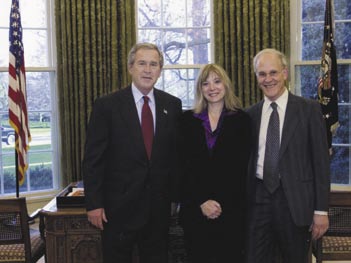 The White House traditionally holds a reception honoring American laureates each year. President George Bush received laureate David Gross and his wife Jackie in the Oval Office. Photo courtesy Whitehouse Communications.
The White House traditionally holds a reception honoring American laureates each year. President George Bush received laureate David Gross and his wife Jackie in the Oval Office. Photo courtesy Whitehouse Communications.
In addition to a trip to Stockholm in December 2004 to receive his Nobel Prize, Gross attended ceremonies the previous month in Paris, where he received France's highest scientific honor, the Grande Médaille d'Or (the Grand Gold Medal).
Winner of a prestigious MacArthur Foundation fellowship in 1987, Gross was elected an American Physical Society fellow in 1974, an American Academy of Arts and Sciences member in 1985, a National Academy of Sciences member in 1986, and an American Association for the Advancement of Science fellow in 1987. He is the recipient of the J. J. Sakurai Prize of the American Physical Society in 1986, the Dirac Medal in 1988, the Oscar Klein Medal in 2000, the Harvey Prize of the Technion in 2000, and the High Energy and Particle Physics Prize of the European Physical Society in 2003. He has received two honorary degrees.
